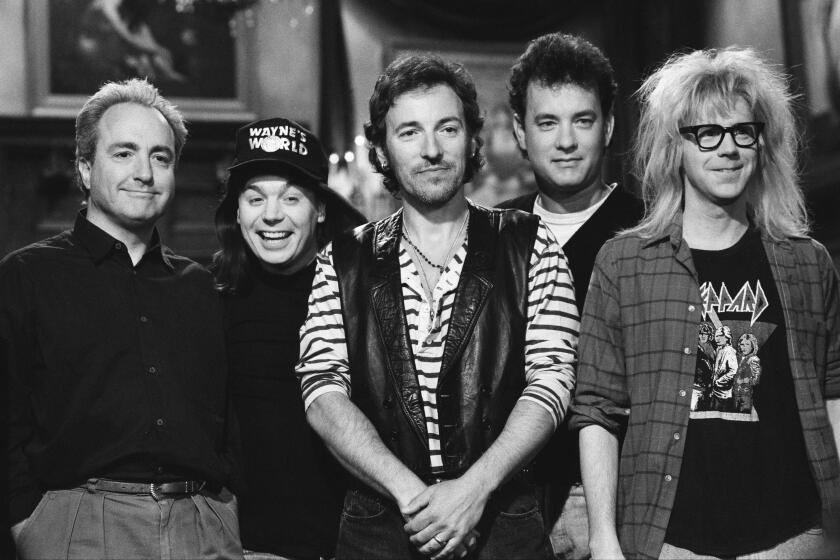THE STORY OF JUNK.<i> By Linda Yablonsky</i> .<i> Farrar, Straus & Giroux: 328 pp., $23</i>
- Share via
Having both lived through and written about heroin addiction, I have some idea of the motivation that goes into wanting to write a novel about junk. There is something so profoundly shattering to one’s sense of self about becoming a junkie that you almost have to tell the story of how the addiction happened in order to exorcise the demons from your psyche. You imagine that in telling it you can dissect its parts, uncover its secrets and end up knowing why it happened, what drove you to that abject state of sheer desperation and affectless amorality that separates a junkie from the rest of society.
In “The Story of Junk,” Linda Yablonsky sets up that dramatic quest, right off the bat, with a bust. The nameless protagonist of her novel, written in the first person and present tense, is a heroin dealer. One day there’s a knock on her door, and she finds herself with an apartment full of federal Drug Enforcement Administration agents, the main one conveniently named Dick.
“ ‘So,’ says Dick. ‘How did a nice girl like you end up in a dirty business like this?’ He gives me a silly grin.
“ ‘Look, I’m just a junkie, that’s all.’ My shoulders sag. ‘Anyone can be a junkie.’ ”
I’ve always thought the best metaphor for heroin addiction is the fable of the vampire. Both involve initiation into a secret world of blood which, once tasted, creates an insatiable hunger so intense the creature will do anything to ease the suffering resulting from its lack so as to reexperience the euphoria that follows its ingestion.
The underground world of the junkie, is also, in its way, as morbidly fascinating as the fictional world of the vampire. It has its own rules, its own hours and inhabitants who, having freed themselves from the constraints of everyday life, vacillate between a bottomless pit of suffering as dark as any imaginable and a state of bliss that seems almost impossible for humans to approach. Unfortunately, the price of admission to this world is high: sometimes your life, always your soul.
The particular world of “The Story of Junk” is Lower Manhattan in the 1980s, when the Lower East Side was a flourishing drug supermarket complete with hawkers and competing brand names, a most unusual confluence of raw consumerism and outlaw cachet. The punks, who made the music of the day, roamed its streets for dope. In Yablonsky’s book, this world is accurately described down to its smallest details: the yellow paper bindles in which they packaged dope at a spot called Lareda on 10th Street and Avenue C.
Yablonsky’s character is a “house connection.” Her customers call and come over at all hours of the day and night. They wait on the benches outside her house and, once inside, sit by her side in her office as she weighs the dope on a triple-beam scale. Her girlfriend Kit is a guitarist in a well-known punk band, the Toast. (“We’re Toast,” the band announces as they leave the stage.) Although our nameless narrator is tortured by the fact that she’s a writer who doesn’t write, her present concerns are always more compelling and her creative aspirations are somewhat satisfied by her immersion in the demimonde of artists and musicians who buy her product. The world is hip and so is its character: jaded, cynical, world-weary and above it all:
“To break even, I’ll have to cut the dope even more. Instead, I raise the price. Isn’t this the best dope money can buy?
“OK, then. Let money buy it.”
It’s certainly tempting for a writer who’s been steeped in this world to take the reader on an unembellished journey through it, and that’s what Yablonsky does. There’s no perspective, no commentary, no pious moralizing, which I appreciate. Yablonsky is a skillful writer. I suppose one can’t make the point too many times that addiction is not a moral issue, that it has nothing to do with a lack of willpower and inherent bad character but that it and does happen to anyone. It’s obvious that this is a story told after she has kicked the habit. It would be difficult for the character to tell her story in the midst of addiction.
The Faustian conflict of having sold your soul to the devil is always present in any tale of addiction, as is betrayal. The devil’s implied presence in the story, and the gritty real-life experience, add to the book’s allure, to the veneer of hipness that could destine it to become a cult classic. I’ve seen one review that referred to it as “Trainspotting in Manhattan.”
This unrelenting tone of bored hipness is what I like least about the book, though it will probably guarantee its success. There are times when it works, and it certainly adds humor to some very grim incidents in the story, but I want more reflection and variation in tone from the character in the end. This is, after all, a life-and-death matter--and the heavy dose of rock ‘n’ roll attitude is just a pose to keep this realization at bay. “Forget cool,” a drug counselor told a friend of mine when she finally wound up in rehab. “Cool is over.” In other words, it’s tough to get a distance from drugs when you’re still caught up in their mystique.
The literature of junk has become a genre. So it’s a wee bit pretentious to call this “The Story of Junk,” as though no one had ever written it before. Thomas De Quincey wrote “Confessions of an English Opium-Eater” in 1822. There’s William Burroughs’ “Naked Lunch” and “Junky,” John Rechy’s “City of Night,” Nelson Algren’s “The Man With the Golden Arm,” James Fogle’s “Drugstore Cowboy,” Tony Sanchez’s “Up and Down With the Rolling Stones” and Rock Scully’s “Living With the Dead,” among many others. Yablonsky says the story’s always the same, but that’s not technically true; the stories vary quite a bit, though seduction and betrayal remain recurring themes.
I don’t know if Yablonsky ever discovered what made her become a junkie through writing this book. I certainly didn’t, though I expected to. I hope the book managed to answer more questions for her than the one the narc asks at the beginning, because ultimately that’s not a very interesting question.
So what we’re left with is the epigraph by James Baldwin: “For, while the tale of how we suffer, and how we are delighted, and how we must triumph is never new, it always must be heard. There isn’t any other tale to tell, it’s the only light we’ve got in all this darkness.”
More to Read
Sign up for our Book Club newsletter
Get the latest news, events and more from the Los Angeles Times Book Club, and help us get L.A. reading and talking.
You may occasionally receive promotional content from the Los Angeles Times.









